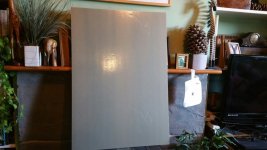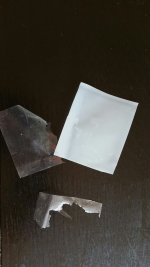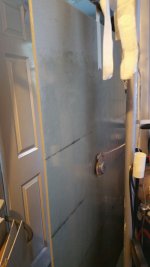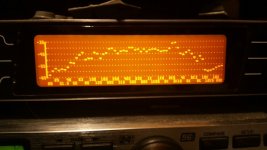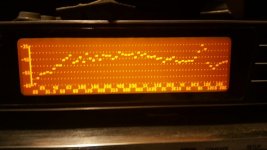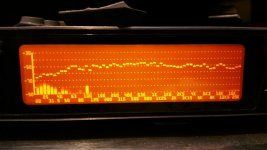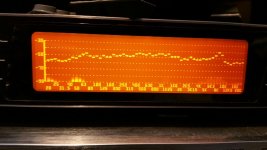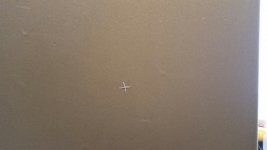When I first got my deq I tried to eq my TLS ,I had a lovely flat response, the trouble was the speakers sounded flat too, they sounded terrible.
A dml room response can change by moving the microphone left or right a few inches ,which response do you eq ?
You could be filling in a dip in one microphone position and causing a spike in another position.
Steve.
A dml room response can change by moving the microphone left or right a few inches ,which response do you eq ?
You could be filling in a dip in one microphone position and causing a spike in another position.
Steve.
Yea I am having that dillemma as well. My listening room is a kitchen with hardwood floors and all kinds of kitchen related furniture so it's kind of a crap shoot. I think getting different measurements to see how the response changes around the room is a start. Then maybe tuning to the positions nearest where you listen the most is it.
With my ceiling hung speakers off axis response is probably more important than on axis response so that's driving how I plan to measure and tune. But thats def something worth considering.
With my ceiling hung speakers off axis response is probably more important than on axis response so that's driving how I plan to measure and tune. But thats def something worth considering.
Carlmart
I cannot speak for Steve or what the outcome of the following might be, but here's what I plan to do over the next few days.
I have on order some 10mm ultra high density EPS (60x40cm) and some 40x30cm stretched triple gessoed canvas panels. I already have 2 x Tectonic 30w exciters.
I will be trying the following (in no particular order):
1. 400 x 550mm (Silver Ratio) free floating EPS panel operating from about 300hz upwards, beginning with sanding, rounded corners and a little bit of PVA where the exciter is going (Monacor 3/7 + 4/9 position)
2. 400 x 300mm canvas panel with 120 x 88mm (silver ratio) UHD EPS attached centrally with the exciter in the Monacor position relative to the panel as a whole. The small EPS section will be rounded, sanded and again with some PVA just where the exciter goes.
I will not be using diluted PVA on the panels or canvas in the first instance. You can always add, but taking away is more difficult. The UHD EPS I will be using should offer better high end response without EQ than the plywood I'm currently using.
How is it all going to sound and measure? I haven't a clue! But I do have a calibrated UMIK-1 and REW, so will be able to take some measurements. A caveat to all this is that how they sound and measure in my listening room will not be the same as they would in yours. I have about 1.5m between my existing panels and the rear wall, and the soundstage fills the room behind them. I forgot to mention that I run them with a Monacor 15 inch PA driver per side, up to crossover (anywhere from 300 to 500 hz, 24db LR).
I use a miniDSP HD for XO and EQ with a TPA3255 amplifier module per side. I also have a crude prototype passive pre stage for volume control.
The bottom line in all of this is that the only way to learn what's going to work is by doing it, based on the best experiences of others. This time around, I'll be trying something a little different: using a small EPS panel attached to the canvas rather than the plywood used in some setups. Part of the rationale for this is that UHD EPS should be better at the very top end. In addition if we get that extended top end radiating to the rear as well, then we may get more 'air'. Some of the best 'point and squirt' box speakers have rear or upward facing tweeters to achieve this.
Back in the mists of time in this mammoth thread, I recall DMBLES waxing lyrical about the naturalness of the canvas panels, but ultimately was unsatisfied by the top end. I'm speculating that my EPS implementation may be an improvement. The next few days should tell!
I quite agree , experimenting is the only way to understand dmi ,the more you experiment the more you learn.
Ply if used with a full frequency exciter,will have not only an extended HF response but also a large hump in say the 10k to 20k region.
But this will not give the sound the air you desire.
this is, for me a major problem.
The podium speaker has the same problem.
Hard heavy materials suffer this, as you put it ,loss of air,the only way I could bring some of the AIR back was by adding my thin strip of paper over approximately half of the exciter area.
You have to use your measuring equipment to help find the optimum sounding position.
Maybe one of my domes in the centre might be a better option for a ply panel ?
I have never used vh grade eps so can't comment on its performance.
But eps is very easily damped.
The canvas and triple gesso ,plus glue ,and anything else that is applied will have a strong damping influence on the eps.
The eps will probably loose some efficiency.
I would be interesting to see how the vh grade reacts .
I look forward to seeing you results
Steve.
I did not realize the canvas was lossy. I do have ample power to drive these panels but I'd also like to protect the exciters. Regarding the CF I am thinking of using fiberglass panels instead. They are a lot cheaper and I imagine will have similar performance in an acoustic application.
I will when I get time explain (again) the throw away comment of lossy panels.
Must go.
Steve.
I quite agree , experimenting is the only way to understand dmi ,the more you experiment the more you learn.
Ply if used with a full frequency exciter,will have not only an extended HF response but also a large hump in say the 10k to 20k region.
But this will not give the sound the air you desire.
this is, for me a major problem.
The podium speaker has the same problem.
Hard heavy materials suffer this, as you put it ,loss of air,the only way I could bring some of the AIR back was by adding my thin strip of paper over approximately half of the exciter area.
You have to use your measuring equipment to help find the optimum sounding position.
Maybe one of my domes in the centre might be a better option for a ply panel ?
I have never used vh grade eps so can't comment on its performance.
But eps is very easily damped.
The canvas and triple gesso ,plus glue ,and anything else that is applied will have a strong damping influence on the eps.
The eps will probably loose some efficiency.
I would be interesting to see how the vh grade reacts .
I look forward to seeing you results
Steve.
As Daniel Whitehall says in the Marvel Cinematic Universe: "I don't know, but we'll learn. Discovery requires experimentation.". Mind you, I'll be sacrificing EPS and art canvases, not mutants.
UHD EPS has arrived. Canvas panels arrived yesterday. Final local league cricket match of the season on Saturday with yours truly behind the camera. Unfortunately timed photography road trip next week. Just when you get back full-on into hifi mode, other hobbies get in the way. Could be worse - I might not be retired...
Some pictures of what I am playing around with at the moment.
The first picture on the left is the second epoxied panel drying next to my surround sound panel.
The quite thick coating uses about 20g per side,the first panel had a messy 20g one side and a smooth 10g on the other side.
The second picture is of the thin epoxy that peeled off of the pp that I used to mix the epoxy.
At first I could not tell the difference between the epoxy and the pva, but where the pva would stretch when pulled apart, the epoxy just breaks .
Picture three is the exciter that I have just cut off of an eps panel.
the fourth picture is the first messy panel in position showing that I have the exciter glued on with pva on the thicker messy side.
Having to wait a day for each side to dry is a pain , as my new boss (I'm retired too) always seems to have new jobs for me to do ,so I loose another day🙄
Stratotron.
Do you know if you can apply a second coat of epoxy ?
Do you have to sand the surface first?
I seem to remember someone saying you can't epoxy over epoxy?
Steve.
The first picture on the left is the second epoxied panel drying next to my surround sound panel.
The quite thick coating uses about 20g per side,the first panel had a messy 20g one side and a smooth 10g on the other side.
The second picture is of the thin epoxy that peeled off of the pp that I used to mix the epoxy.
At first I could not tell the difference between the epoxy and the pva, but where the pva would stretch when pulled apart, the epoxy just breaks .
Picture three is the exciter that I have just cut off of an eps panel.
the fourth picture is the first messy panel in position showing that I have the exciter glued on with pva on the thicker messy side.
Having to wait a day for each side to dry is a pain , as my new boss (I'm retired too) always seems to have new jobs for me to do ,so I loose another day🙄
Stratotron.
Do you know if you can apply a second coat of epoxy ?
Do you have to sand the surface first?
I seem to remember someone saying you can't epoxy over epoxy?
Steve.
Attachments
The first picture on the left shows my old friend spike at about 9k this time.
This is a problem I have mentioned many times, but this one is quite bad.
This was measured at about 6 inches distance,
The second picture is from the exciter side, again from 6 inches from the exciter .
You will notice that the 9k spike has reduced greatly but a spike has now apeared at 3k .
I believe this is a combination of the distortions in the exciter coil area (not voice coil resonance )and the cavity resonance.
I saw this the first time I hooked up the first panel and thought I'd see if I could fix it as usual on the second panel, the only problem was I forgot 🙄
It would have been so much easier if I'd made the alterations before I aplied the epoxy 😱
I haven't noticed any nasty sounds over the last few days ,but I've been playing some Tom waits and am now getting some earache.
I know what you are thinking, that's just ,Tom waits, 😀
The panel starts getting that hardness I talk about ,it can be quite painful.
You will also notice the response from the back of this panel rolls off after 3k to 4k.
The panel surfaces have different responses above 3k .
I think I should be able to improve the front surface response but the rear surface will probably stay the same.
A lot of the hf is blocked by the exciter itself plus phasing issues.
We shall see.
Steve.
This is a problem I have mentioned many times, but this one is quite bad.
This was measured at about 6 inches distance,
The second picture is from the exciter side, again from 6 inches from the exciter .
You will notice that the 9k spike has reduced greatly but a spike has now apeared at 3k .
I believe this is a combination of the distortions in the exciter coil area (not voice coil resonance )and the cavity resonance.
I saw this the first time I hooked up the first panel and thought I'd see if I could fix it as usual on the second panel, the only problem was I forgot 🙄
It would have been so much easier if I'd made the alterations before I aplied the epoxy 😱
I haven't noticed any nasty sounds over the last few days ,but I've been playing some Tom waits and am now getting some earache.
I know what you are thinking, that's just ,Tom waits, 😀
The panel starts getting that hardness I talk about ,it can be quite painful.
You will also notice the response from the back of this panel rolls off after 3k to 4k.
The panel surfaces have different responses above 3k .
I think I should be able to improve the front surface response but the rear surface will probably stay the same.
A lot of the hf is blocked by the exciter itself plus phasing issues.
We shall see.
Steve.
Attachments
With the Amina exciter you could remove the flat plate and bolt the exciter directly to both sides of the panel.
This should remove the spikes ? If they exist ?
But this would give both surfaces, front and back ,good contact with the exciter.
On hard panels such as ply ,you would not need a bracing support.
Of course the bolt is mounted in the centre of the exciter spider,so what effect this might have I don't know,but if this is a problem,it would be there anyway ?
Just an idea if anyone wants to experiment.
Steve.
This should remove the spikes ? If they exist ?
But this would give both surfaces, front and back ,good contact with the exciter.
On hard panels such as ply ,you would not need a bracing support.
Of course the bolt is mounted in the centre of the exciter spider,so what effect this might have I don't know,but if this is a problem,it would be there anyway ?
Just an idea if anyone wants to experiment.
Steve.
Last edited:
Right.
I've just done a very quick and dirty test of four flat speaker candidates - just holding the exciter against each candidate to gain some initial insights. Amplifier volume remained unchanged throughout. I used my recently arrived Tectonic 30w exciters.
1. 400 x 300mm Stretched Art Canvas, no treatment, or plywood addition. The sound is muffled and the volume is the lowest by a country mile.
2. 400 x 565mm Medium Density EPS, PVA treated, rounded corners, exciter in the 'Monacor' location. Less muffled than the art canvas, but doesn't seem that dynamic. Decent tonal range. Volume higher than the canvas panel. Weighs in at 50g.
3. 400 x 565mm 3mm Poplar Ply, PVA treated, rounded corners, exciter in the Monacor position. Warm toned and quite punchy. Surprisingly a little louder than the treated medium grade EPS. Overall, more pleasing than the previous EPS, but ultimate treble extension and 'air' may still be an issue. Less damping perhaps. Still worth trying with the new exciters though. Tips the scales at 250g.
4. 400 x 600mm 10mm Ultra High Grade EPS as delivered by the postman with no sanding, treatment, corner rounding. Shows great potential. Highs seem to offer more extension than the ply panels. Sound punchy. Volume louder still than the plywood panels. Comes in at 75g before trimming and corner rounding, so somewhere between 65 & 70g after this is done.
The ultra high grade EPS shows much promise. It would seem to offer the potential combination of highest efficiency, best treble response, nice punchiness and all-round good tonal balance. There's enough flex in it as well as high compressive strength. And of course it's light.
Test plan.
1. Trim UHD EPS panel to patent ratio (1:1.41) and round corners.
2. Sand both sides to remove hot wire skin and get smooth finish.
3. Sand edges and corners. I believe this is supposed to help deal with the 'wrong sort of waves'.
4. Apply small amount of PVA glue to the exciter position (Monacor 3/7 (W) + 4/9 (H)) and let dry
5. Experiment with different mountings
(a) As free floating as possible
(b) Addition of 3mm self-adhesive neoprene foam to secure parts of the panel to the oversized frame - very similar to how my plywood panels were attached.
(c) Consider applying diluted PVA if needed. I suspect it will be fine without.
(d) Consider experimenting with the old DMLBES (now banned from the site it would seem) method of physically attaching the panel to a frame with some sort of cushioning glued between panel and frame. This may prove to be more trouble than it's worth, but I could experiment with a smaller EPS panel attached to one of the canvas frames (minus the canvas)
If (a) and /or (b) sound good off the bat, I may not need (c) and definitely not (d).
My oversize frames lend themselves well to trying exciter bracing. So I'll add with / without exciter brace / spline thingy as a consideration.
Bear it in mind that the panel will be used from about 300hz upwards with the bottom end given over to a 15 inch open baffle bass driver. XO & EQ duties will be handled by a miniDSP HD.
With a bit of luck and a dry day, I should be able to put up an initial frequency plot or two tomorrow.
I've just done a very quick and dirty test of four flat speaker candidates - just holding the exciter against each candidate to gain some initial insights. Amplifier volume remained unchanged throughout. I used my recently arrived Tectonic 30w exciters.
1. 400 x 300mm Stretched Art Canvas, no treatment, or plywood addition. The sound is muffled and the volume is the lowest by a country mile.
2. 400 x 565mm Medium Density EPS, PVA treated, rounded corners, exciter in the 'Monacor' location. Less muffled than the art canvas, but doesn't seem that dynamic. Decent tonal range. Volume higher than the canvas panel. Weighs in at 50g.
3. 400 x 565mm 3mm Poplar Ply, PVA treated, rounded corners, exciter in the Monacor position. Warm toned and quite punchy. Surprisingly a little louder than the treated medium grade EPS. Overall, more pleasing than the previous EPS, but ultimate treble extension and 'air' may still be an issue. Less damping perhaps. Still worth trying with the new exciters though. Tips the scales at 250g.
4. 400 x 600mm 10mm Ultra High Grade EPS as delivered by the postman with no sanding, treatment, corner rounding. Shows great potential. Highs seem to offer more extension than the ply panels. Sound punchy. Volume louder still than the plywood panels. Comes in at 75g before trimming and corner rounding, so somewhere between 65 & 70g after this is done.
The ultra high grade EPS shows much promise. It would seem to offer the potential combination of highest efficiency, best treble response, nice punchiness and all-round good tonal balance. There's enough flex in it as well as high compressive strength. And of course it's light.
Test plan.
1. Trim UHD EPS panel to patent ratio (1:1.41) and round corners.
2. Sand both sides to remove hot wire skin and get smooth finish.
3. Sand edges and corners. I believe this is supposed to help deal with the 'wrong sort of waves'.
4. Apply small amount of PVA glue to the exciter position (Monacor 3/7 (W) + 4/9 (H)) and let dry
5. Experiment with different mountings
(a) As free floating as possible
(b) Addition of 3mm self-adhesive neoprene foam to secure parts of the panel to the oversized frame - very similar to how my plywood panels were attached.
(c) Consider applying diluted PVA if needed. I suspect it will be fine without.
(d) Consider experimenting with the old DMLBES (now banned from the site it would seem) method of physically attaching the panel to a frame with some sort of cushioning glued between panel and frame. This may prove to be more trouble than it's worth, but I could experiment with a smaller EPS panel attached to one of the canvas frames (minus the canvas)
If (a) and /or (b) sound good off the bat, I may not need (c) and definitely not (d).
My oversize frames lend themselves well to trying exciter bracing. So I'll add with / without exciter brace / spline thingy as a consideration.
Bear it in mind that the panel will be used from about 300hz upwards with the bottom end given over to a 15 inch open baffle bass driver. XO & EQ duties will be handled by a miniDSP HD.
With a bit of luck and a dry day, I should be able to put up an initial frequency plot or two tomorrow.
The weight of the uncoated xps panel is 82g and with the epoxy coating it is 122g.
Depending on how this goes I might try the thinner 10g per side similar to the front side of the first messy epoxy panel .
Making the panel 102g might change things a little?
The new epoxy panel is still sounding quite dead compared to the messy panel, it takes a long time to cure🙄
I'm still going to hook it up to day and see how it sounds.
The wife is out for most of the day , so freedom calls😀
Steve.
Depending on how this goes I might try the thinner 10g per side similar to the front side of the first messy epoxy panel .
Making the panel 102g might change things a little?
The new epoxy panel is still sounding quite dead compared to the messy panel, it takes a long time to cure🙄
I'm still going to hook it up to day and see how it sounds.
The wife is out for most of the day , so freedom calls😀
Steve.
9k spike and 2.5k spike
The quick way to sort out the spike caused by the coil surface area is to place a dot of blutack in the centre, but this wasn't enough, so I made a x there instead and this did a better job ,but still not totally cleared.
The second picture is without the x .(I somehow lost my pictures and had to upload them again,but got them in the wrong order) 😡
The first picture is with the x.
Notice how the response above 10k has improved.
There is a lot of cancellation that can go on there.
The third picture is from behind the exciter (all measurements done at 6inches) but done with 10db plot to match previous plots.
The 2.5k spike is still there but has changed slightly, this is coming from the hole in the rear of the exciter and the exciter in general.
If I place my hand over the exciter these frequencies drop away.
If I cup my hand around the exciter the noise gets very loud.
The fourth picture is the very thin x in the exciter ring area obviously I could make this thicker but don't want to damp it too much.
Steve.
The quick way to sort out the spike caused by the coil surface area is to place a dot of blutack in the centre, but this wasn't enough, so I made a x there instead and this did a better job ,but still not totally cleared.
The second picture is without the x .(I somehow lost my pictures and had to upload them again,but got them in the wrong order) 😡
The first picture is with the x.
Notice how the response above 10k has improved.
There is a lot of cancellation that can go on there.
The third picture is from behind the exciter (all measurements done at 6inches) but done with 10db plot to match previous plots.
The 2.5k spike is still there but has changed slightly, this is coming from the hole in the rear of the exciter and the exciter in general.
If I place my hand over the exciter these frequencies drop away.
If I cup my hand around the exciter the noise gets very loud.
The fourth picture is the very thin x in the exciter ring area obviously I could make this thicker but don't want to damp it too much.
Steve.
Attachments
Last edited:
Do you know if you can apply a second coat of epoxy ?
Do you have to sand the surface first?
I seem to remember someone saying you can't epoxy over epoxy?
Steve.
I saw somewhere (probably on tech ingredients) that epoxy needs to be sanded between coats, or apply it just before it completely dries up.
Ultra High Density EPS: Sanding and PVA
The UHD EPS is now sanded, corners rounded and edges smoothed. When I marked the exciter position pre-sanding, the marker pen did as you would expect - ride roughly over an uneven, hot wire cut surface with little ink penetration.
On the sanded panel, I re-marked the exciter position. This time, the marker pen worked smoothly with quite a bit of ink penetration.
This got me thinking. I now have an UHD EPS panel that's smooth and almost soft to the touch. I'm very confident that a 50/50 PVA/Water mix will stay where it's put. The question is, is it needed? My instinct says yes, followed by a very light sanding when dry.
The UHD EPS is now sanded, corners rounded and edges smoothed. When I marked the exciter position pre-sanding, the marker pen did as you would expect - ride roughly over an uneven, hot wire cut surface with little ink penetration.
On the sanded panel, I re-marked the exciter position. This time, the marker pen worked smoothly with quite a bit of ink penetration.
This got me thinking. I now have an UHD EPS panel that's smooth and almost soft to the touch. I'm very confident that a 50/50 PVA/Water mix will stay where it's put. The question is, is it needed? My instinct says yes, followed by a very light sanding when dry.
Lordtarqin.
I have not used UHD eps so I can't really comment.
It's been many years since I suggested the idea of sanding off the bad sounding eps skin and replacing it with pva.
But tech ingredients seemed to have missed the point?
And thought it made a good room deadening panel ? As well.
If left with the soft coating ,the sound is softened, as you would expect.
The pva also replaces the rigidity .
I used to do a scratch test to see how the sound travels through the panel, with my sanded panels they sounded soft like a pillow.
This is why I'm a little suspect about leaving sanded panels ?
Steve.
I have not used UHD eps so I can't really comment.
It's been many years since I suggested the idea of sanding off the bad sounding eps skin and replacing it with pva.
But tech ingredients seemed to have missed the point?
And thought it made a good room deadening panel ? As well.
If left with the soft coating ,the sound is softened, as you would expect.
The pva also replaces the rigidity .
I used to do a scratch test to see how the sound travels through the panel, with my sanded panels they sounded soft like a pillow.
This is why I'm a little suspect about leaving sanded panels ?
Steve.
Thanks Steve
That is consistent with my thinking. I have to say that this grade of EPS is really easy to sand without gouging holes in the surface by loosening polystyrene balls. Side one is now PVAed. As expected, it went on smoothly with no run-off. It was quite a surprise as to how soft the surface became after sanding. The raw UHD EPS panel, even in 10mm, is very rigid and with a very firm feel overall. But in the raw, the surface is still pitted with a definite skin from the cutting process. And with sanding, there's a definite soft more porous finish to the surface.
Our kitchen scales are iffy: One panel, trimmed and rounded came in at around 75g. Two identical panels together came in at 170g. I believe the latter weight to be more accurate. So, make that 85g for a 565x400mm 10mm UHG EPS panel before PVA treatment (about 1/3 the weight of my 3mm poplar ply panels - same dimensions except 3mm thick).
I'm feeling optimistic!
Simon
That is consistent with my thinking. I have to say that this grade of EPS is really easy to sand without gouging holes in the surface by loosening polystyrene balls. Side one is now PVAed. As expected, it went on smoothly with no run-off. It was quite a surprise as to how soft the surface became after sanding. The raw UHD EPS panel, even in 10mm, is very rigid and with a very firm feel overall. But in the raw, the surface is still pitted with a definite skin from the cutting process. And with sanding, there's a definite soft more porous finish to the surface.
Our kitchen scales are iffy: One panel, trimmed and rounded came in at around 75g. Two identical panels together came in at 170g. I believe the latter weight to be more accurate. So, make that 85g for a 565x400mm 10mm UHG EPS panel before PVA treatment (about 1/3 the weight of my 3mm poplar ply panels - same dimensions except 3mm thick).
I'm feeling optimistic!
Simon
Also, thinking about it a little more, regardless of EPS grade, sanding is going to be removing the skin that's created by the hot wire cutting process (or extruding in the case of XPS). The skin is going to be covering for the most part the very small polystyrene spheres which, when the skin is removed, will present a rather spongy texture as one would expect - hence the soft feel. I would suggest, therefore, that the diluted PVA treatment is essential to reseal the surface even for UHD grade EPS.
The first side is still damp in places even after four hours drying time. The second will have to wait until tomorrow.
The first side is still damp in places even after four hours drying time. The second will have to wait until tomorrow.
What is this:
https://www.aliexpress.com/item/32912630425.html?ug_edm_item_id=32912630425&edm_click_module=item_detail&tracelog=rowan&rowan_id1=aeug_edm_19479_1_pt_BR_2021-09-10&rowan_msg_id=7648biz_search_product:0:0_3061409$ffc32cd3ac644cedb15ec5b854244008&ck=in_edm_other
Can it be used for low frequencies, crossed to another exciter?
https://www.aliexpress.com/item/32912630425.html?ug_edm_item_id=32912630425&edm_click_module=item_detail&tracelog=rowan&rowan_id1=aeug_edm_19479_1_pt_BR_2021-09-10&rowan_msg_id=7648biz_search_product:0:0_3061409$ffc32cd3ac644cedb15ec5b854244008&ck=in_edm_other
Can it be used for low frequencies, crossed to another exciter?
I've not used PVA yet, but one thing I think it would do is to eliminate panel 'noise'. On a fresh panel if you get very close, you can hear a something like static, or white noise when a percussive note is followed by silence. It's like a hiss spreads out from the exciter and dies away over some (surprisingly large) fraction of a second. I suppose this is what people refer to as panel noise.
The origin of this I guess lies in the fact that polystyrene is brittle, and the surface presents many edges of microscopically cracked polystyrene rubbing together. Covering this with PVA binds the edges together and submerges them in a flexible matrix. I would guess that you could have the same effect by painting with eg silicone oil. PVA would probably also damp HF I imagine.
The origin of this I guess lies in the fact that polystyrene is brittle, and the surface presents many edges of microscopically cracked polystyrene rubbing together. Covering this with PVA binds the edges together and submerges them in a flexible matrix. I would guess that you could have the same effect by painting with eg silicone oil. PVA would probably also damp HF I imagine.
That’s a great explanation - I never knew that XPS exhibited panel noise without the PVA. There are more viscous and pliable things you could coat with. Maybe latex interior wall paint? The PVA is quite hard once dry and might have great HF response. There is the tacky wet look stuff they apply to speaker surrounds and soft dome tweeters.
- Home
- Loudspeakers
- Full Range
- A Study of DMLs as a Full Range Speaker
